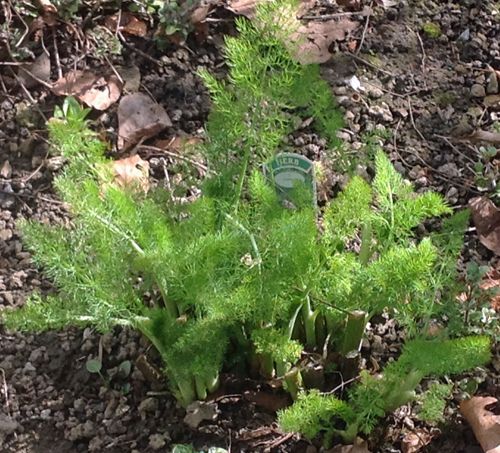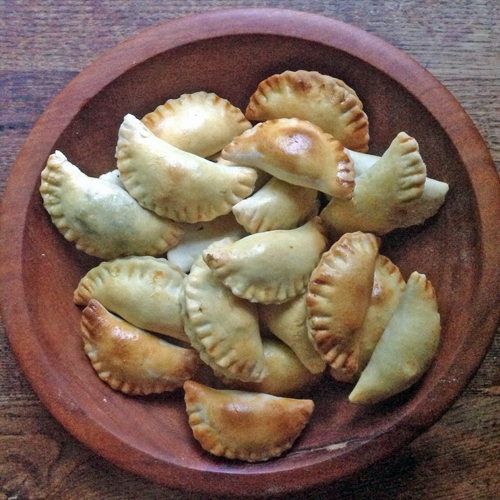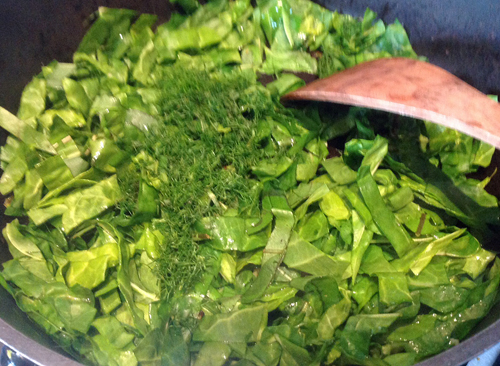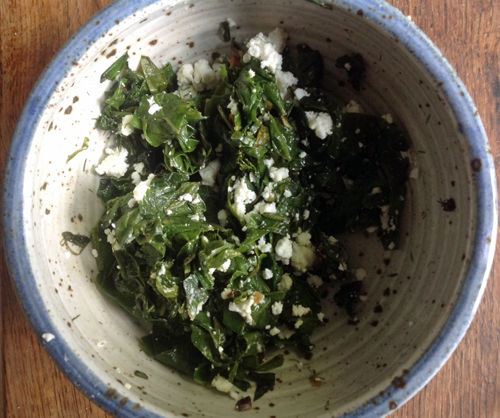In my herb garden is a leafy fennel – not Roman bulb type, but the type that produces lots of feathery fronds that grow on stalks that can reach well over head height by the summer’s end. At the moment, with last year’s stalks cut down, it is a lovely mass of feathery greens just poking through the soil.
The fennel immediately put me in mind of the wild greens I cooked with during one January on Crete, at a time when the island was verdant with new growth. The greengrocers sold a mixture of “greens” called yiachnera – a category of wild and/or cultivated greens, containing wild fennel, mint and leek among other less easily identifiable plants. The mixture changed with the growing season and the availability of plants. More commonly, “greens” – whether wild or cultivated – are generically called horta in Greek.
Horta (including the yiachnera mixture) is often cooked and used as a filling in savoury pies (pites) – large ones, or smaller individual ones. The horta filling can be made up of many different types of greens, but there should be a balance between aromatic herbs, bitter wild greens (such as different species of chicory) and milder cultivated ones. I came up with an easily obtainable combination from my garden, but feel free to make up your own selection of horta. The resulting pies were good, but when making them again, I will increase the amount of aromatics – the fennel and mint.
Hortopites (“Greens” Pies)
These are also another form of kallitsounia – a word used to describe little pastries or pies. They are, however, unlike the sweet cheese ones I posted earlier that are a Cretan Easter tradition.
Makes approximately 2 to 2-1/2 dozen
Filling
- 2 to 3 spring onions
- 2 Tablespoons olive oil
- 200 gr. (7 oz.) Swiss chard
- 6 fronds of fennel
- 8 to 10 wild garlic leaves
- Small handful of young dandelion leaves (wild ones are very bitter, so less is better)
- 1 sprig of mint (approximately 2 tablespoons finely chopped mint)
- 1/4 cup crumbled feta (optional)
Clean all the greens. Finely chop the spring onions and sauté in a low heat in a large pot. Clean the chard, removing the tough rib. Cut the chard, wild garlic and dandelion leaves (the mild cultivated and bitter wild greens) into fine shreds.
Add the chopped greens to the onions. Finely chop the fennel and mint leaves (the aromatics) and add to the mixture. Stir and cover. Let it steam on low heat for approximately 8 to 10 minutes.
The Cretans call this method of cooking sofegada – that is, cooking in its own steam. The term is not originally a Greek word, but is a Venetian Italian word meaning suffocation. Since Crete has a long history as a Venetian colony (from the 13th to the 17th centuries), its origin likely dates from that time. It may also be an example of culinary cultural borrowing, similar to traditional Italian cooking methods (such as in the production of soffritto).
The greens should have wilted. Remove the lid and continue cooking until any liquid has evaporated. Turn the greens out into a bowl. Once cool, stir in the feta. Set aside while you make the dough.
Dough
- 2 cups flour
- 1 teaspoon salt
- 1/2 cup water
- Juice from 1/2 lemon
- 2 to 3 Tablespoons olive oil
Place the flour and salt in a mixer bowl. Pour the liquids (water, oil and lemon juice) and turn the mixer on. Add more oil if it appears too dry. Mix until a rough dough ball forms. You may need to form the final ball with your hands. Cut in two.
Assemble & Bake
- Dough
- Filling
- 1 egg
- 1 Tablespoon water
Preheat oven to 350 degrees F. and prepare a baking tray by lining it with baking parchment. In a small bowl, beat the egg and water. Set aside.
Take one of your dough balls and roll out until it is very thin. Using a circular cookie or scone cutter (approximately 3 inches in diameter), cut out circles of dough. Place about 1 teaspoon of the filling on one side of the circle, keeping it away from the edge. With a pastry brush or your finger, dab on the egg wash on the edges. Fold the circle over the filling and pinch the edges and then crimp with the tines of a fork. Repeat the process for the remaining dough and filling.
Hortopites are generally made larger, but I made mine small to be served as mezze (“little nibbles”). They could almost be called hotopitakia – with the diminutive suffix added to the name. To make larger ones, keep the thickness of the dough thin as these smaller ones while increasing the amount of filling.
Place the semi-circular hotopites on the parchment lined baking tray. Brush the tops with the egg wash.
Bake in the preheated oven for 20 minutes until golden brown. Another method of cooking is to simply fry them in a little olive oil until browned on both sides. Serve warm or at room temperature.
Notes:
- There is a good description of Cretan “greens” on Organically Cooked, an informative blog by a New Zealander transplanted to Hania, Crete.
- Dandelion (Taraxacum officinale) is a variety of wild chicory – Cichorieae. Different types of cichorieae (which includes salsify, dandelion and common chicory) are standard ingredients in hortopites, providing the bitter element. Cultivated dandelion is available in some markets and is not as bitter as its wild cousin that lives in your lawn.
- When picking wild greens it is important that you are able to identify the plant and that you pick in areas where you are certain no pesticides were used.









I wonder if you’ve ever read Honey from a Weed. One of the most wonderful books of all time. But it’s you who’ve reminded me and inspired me here…. A wonderful post. Gonna make some sweet horta pies`! 🙂
LikeLike
Yes!!! One of my most favourite books! I just wished she had written more of the same sort of thing, but she only wrote a few odd ones – Centaurs Kitchen (now available through Prospect Books, The English Kitchen Series), Plats du Jour (cheap secondhand) and Ring Doves and Snakes (expensive secondhand). I had always wondered what Patience Gray’s life was like. Lots of ups and downs, lots of adventure and chaos…
LikeLiked by 2 people
The Hortopites look lovely. I must remember this recipe in spring. The Greek restaurants here do some tasty salads , just called Horta salads, and it brings to mind the prefix, horto for horticulture. In Italian, a veggie garden is an Orto. All very nice and green.
LikeLiked by 2 people
Horta can be so many things! The basic summer horta that appears on restaurant menus is usually vlita (amaranth in English) which is a cultivated veg in Greece. My linguistically minded husband says horta is from ancient Greek, but is a cognate of the Latin hortus (garden) from which horto/orto is derived. I guess that means the words have a common relative somewhere back in the Indo-European language tree. I’m going to make these again, but up the mint and fennel. They went over very well!
LikeLike
amaranth! I have been noticing various uses of leaves in this family in blogs from India– on my radar now. Also as a member of the goosefoot family (?) and am desperately hoping that something weedy in my raised bed is the Good King Henry I planted last year…..
LikeLike
Amaranth is lovely as a steamed/ boiled veg – serve at room temp with drizzlings of good olive oil and a squeeze of lemon. I’ve often seen it paired with baby courgettes this way. It’s a cooked salad served as a mezze. I tried growing it in Oxford, but even in S England it was still too cold. It needs a really warm environment.
LikeLiked by 1 person
Oh my gosh – I was immediately reminded of Honey from a Weed when I began reading this – I must look up the three you mention in your reply above; my Amazon wish list is a little out of control but very handy to have as a reference! I had no idea that dandelions were a variety of chicory – we have a little endive in nearly every salad I make these days so I shall bring up that little fact over dinner tonight! Also had no idea that Crete was a Venetian colony for 400 years – that will also go down well tonight as Jake is a fact monster and has been to Venice. These hotopitakia would be great for a mezze – I am bookmarking!
LikeLike
I love Patience Gray’s book! And, my wishlist(s) are also out of control! Another fact – El Greco’s real name was Doménikos Theotokópoulos from Crete during the Venetian days – hence his nickname “the Greek”. I’ve been to his birthplace – a lovely village in a valley filled with orange trees. Under the Venetians, Crete had a flourishing cultural life – art, literature, music. Lots of Venetian remains are still to be seen – not least the fortresss on the North coast of the island.
LikeLiked by 1 person
What beautiful looking greens! I love the look of your little pies too… look fabulous!
LikeLike
My boys really loved them! They were gone in a trice. Will make more soon while the herbs and dandelions are still young and fresh, but will probably double the mint + fennel content since it virtually got lost in the stronger flavours.
LikeLike
Lovely!
LikeLike
Foragers unite! Although, the only foraging I did was pick a few dandelion leaves. The rest came from the herb garden and the greengrocer. Have to work these again adjusting the balance of bitter to aromatics. Work-in-progress!
LikeLike
what a delish little meal! And I wish my greengrocer sold yiachnera – sounds like a perfect chance to experiment.
LikeLike
I wish they sold yiachnera here, too. Even better, I wish I could be on Crete, although there seems to be some move by the Greek government to close down open-air markets at the moment. Shame if it comes to that. These little pies are a work in progress – next batch modified with more mint and fennel.
LikeLike
They look so good! I love pies/pastries of any kind! These don’t seem to be as unhealty as others.. Green foods always make me feel like eating something healthy..
LikeLike
They are good … and good for you. The Greeks (and Cretans especially) eat a lot of greens – much of it foraged. However, that said, the younger generation don’t forage much and as a result are losing knowledge of what wild greens are edible.
LikeLike
I’m very impressed, cultivated wild greens in your garden. It is civilized foraging. I love bitter greens, they always taste good, and really traditionally made with what’s to hand. I haven’t read Patience Gray since 1997, it was a departing gift when I left a job, 5 minutes ago I pulled Honey From A Weed from the bookcase for a reread.
LikeLike
Funny, that…I just pulled Honey From A Weed off my shelf as well. What a wonderful read. The dandelions were, indeed, wild. My grandmother used to make a raw salad of dandelion leaves and a warm sweet-sour bacon dressing. Hmm…may try that next. The “wild” garlic I planted years ago to spread under the canopy of the bay – so, now cultivated? Everything else, I’m afraid is definitely cultivated and civilized!
LikeLike
They are so cute! I love the lemon in the dough, I’m sure it brings an interesting flavour to your horta!
LikeLike
They are cute! The lemon (or sometimes vinegar or even a grappa-like spirt called raki) is a normal ingredient in this kind of dough. I guess an acid is needed to suspend the oil – a guess, as I’m not really a food chemist. The dough is often called homemade phyllo – a rustic version of those very thin sheets you get in the supermarket.
LikeLike
I know raki, it’s an interesting recipe! thanks again
LikeLike
I love to travel with you and through your kitchen! 🙂
I learned a new intriguing recipe and i really love the mix of herbs you used! 🙂
LikeLike
I love Greek horta – all sorts. Though, it was an adventure for me to recreate these with greens in my own garden.
LikeLike